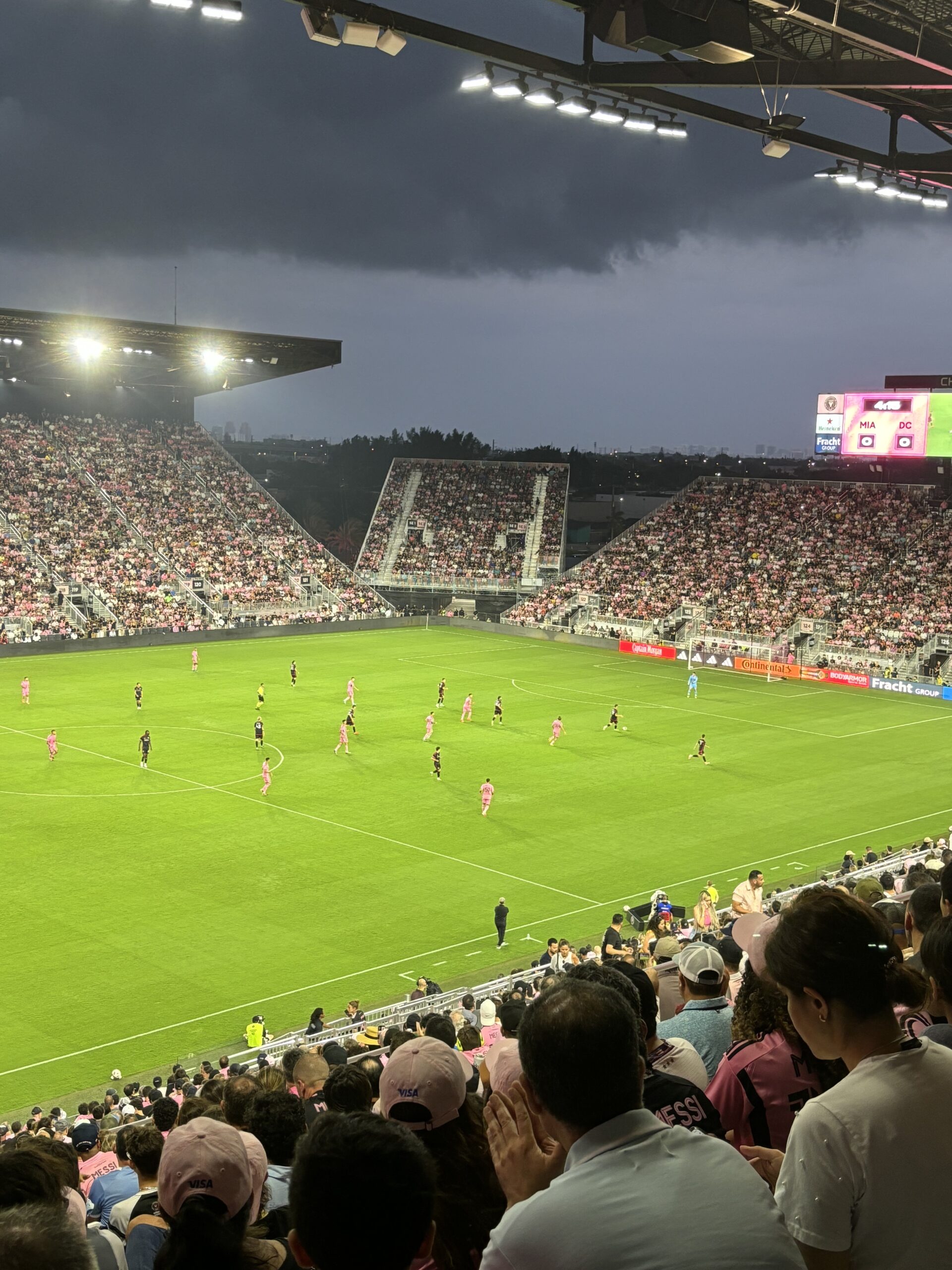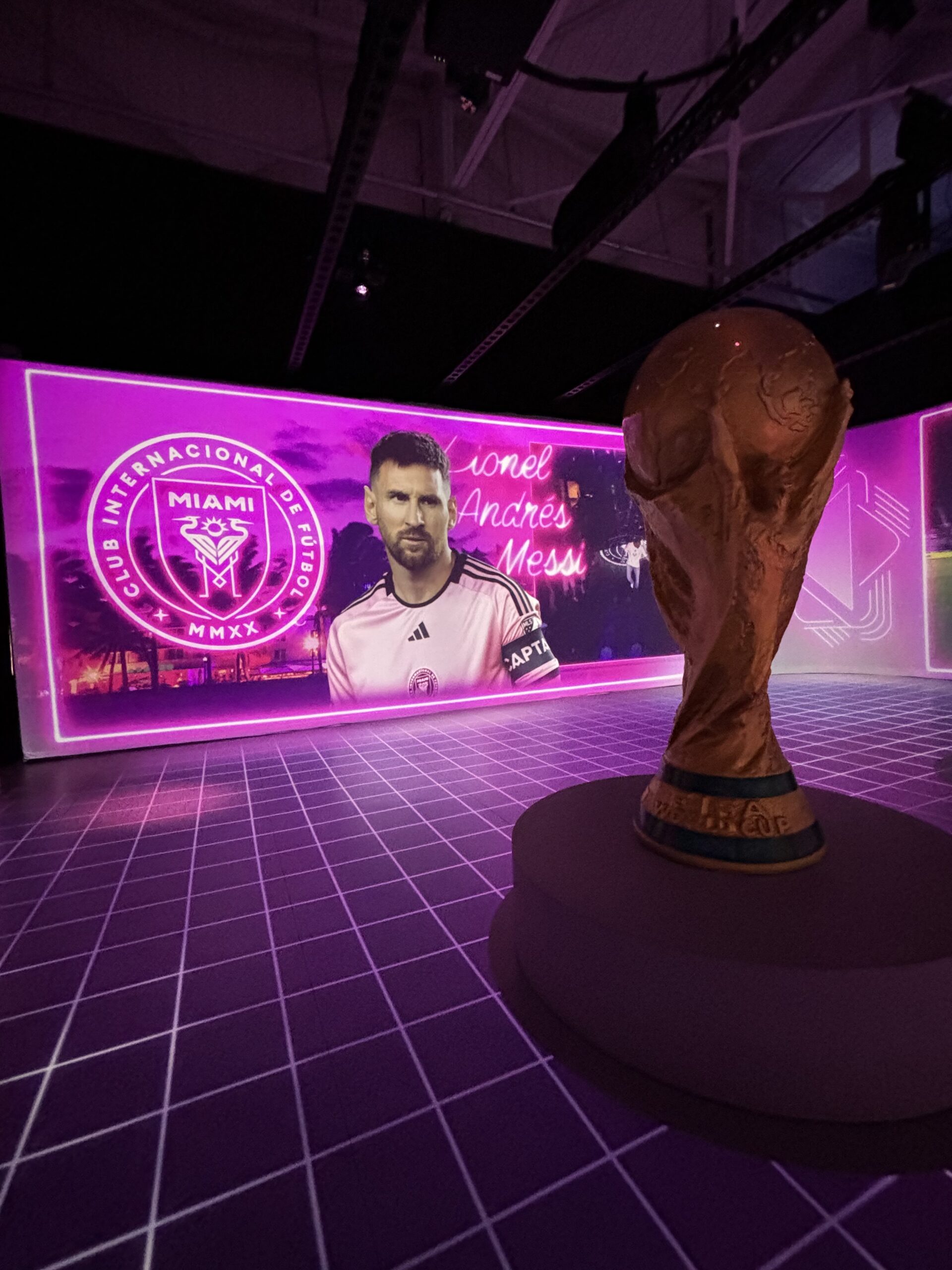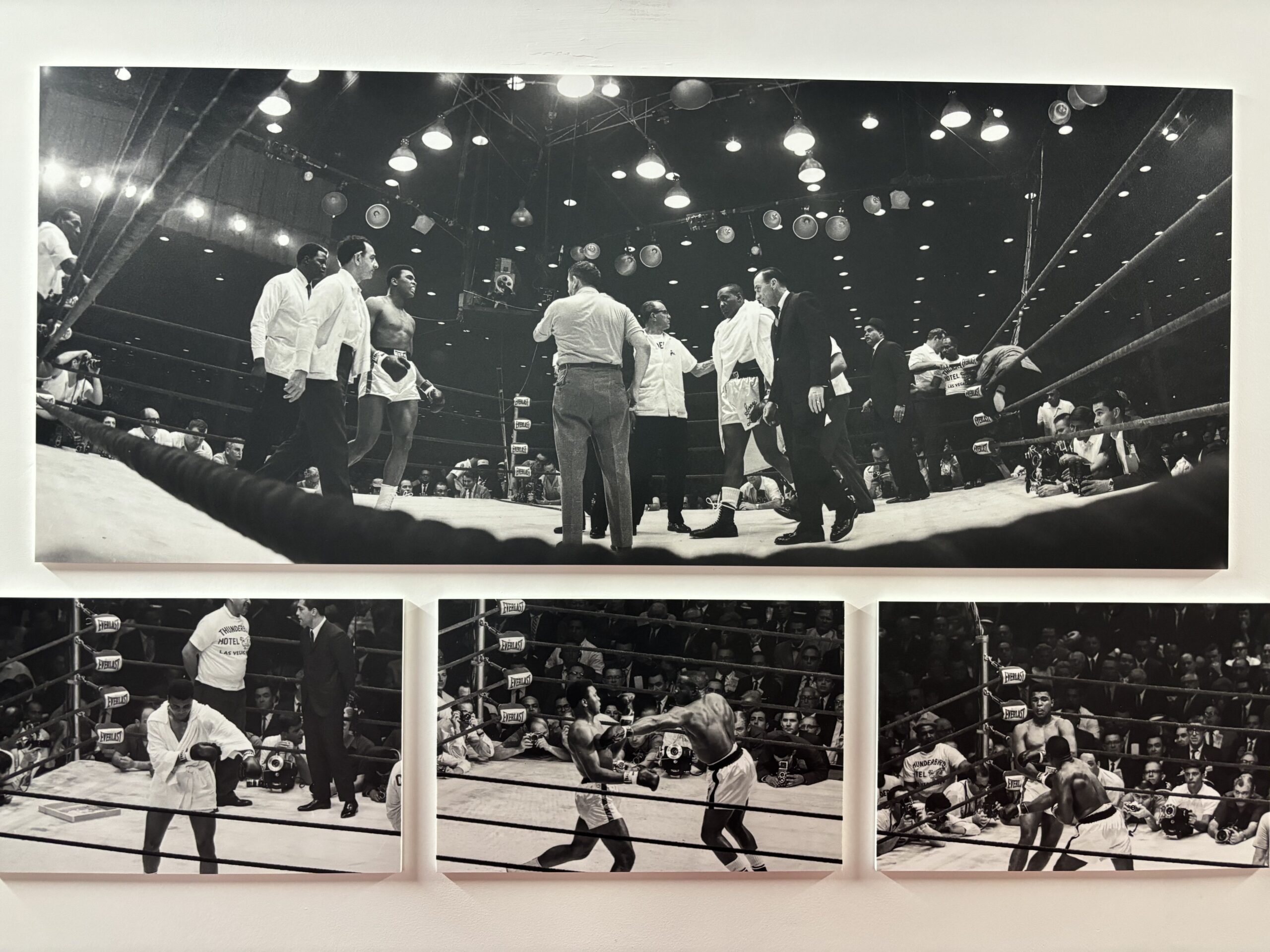Messi’s Presence Elevates Miami’s Global Profile
In the home of many championship teams, soccer star's arrival has made it an even hotter sports destination
Posted On: June 25, 2024 By :
It’s raining on this Saturday evening — and raining hard, the air so thick with humidity the past few days on this mid-May weekend the skies could not handle the intensity of the heat.
The referee’s whistle blows and a free kick is given to the home team, Inter Miami. It’s starting to rain sideways now, even those underneath the canopy at Chase Stadium can feel the moisture. But that is not going to stop anyone from watching this moment. As the rain intensifies by the second, so does the fans taking out their phones to record the moment while chanting: “Messs-iiii … Messs-iii … Messs-iii.”
The free kick goes into the wall. The phones are put back down … for now. Every quick move, every interchange, the shot late in the second half that rises over the crossbar in an eventual 1-0 Inter Miami win — each is met with a roar of anticipation for the once-in-a-lifetime highlight each fan wants to experience and savor.
This is Miami, where champions have played and legends have been made. But even with all of that said, since the arrival of Lionel Messi, the city has been in a sustained global spotlight that few can claim.
Worldwide Reach, Based in Miami
Everything and anything is about Messi. The years-long process of convincing him to come to Miami and Major League Soccer stands as perhaps David Beckham’s greatest achievement and contribution to the sport in the United States. His name is everywhere in Miami, from the streets to the other sports attractions throughout the city.
With Inter Miami in its fourth year at the 19,100-capacity Chase Stadium, there is the recognition that Messi brings about a new fan base around the world to MLS. But for those who have been followers of the sport, there is also the historical aspect; it is on this site, few may realize, where the former Lockhart Stadium was home for the Fort Lauderdale Strikers in the NASL, the first time soccer tried to make inroads in the U.S. sports scene. Now, decades later — after multiple version of the Strikers in various leagues plus MLS’ first foray in South Florida, the Miami Fusion from 1998 through 2002 — it is, for now, a spot where the South American fan culture mixes with high-end food and hospitality activations for sponsors pitchside.
Inter Miami plays and trains at its 34-acre facility in Fort Lauderdale, which along with Chase Stadium includes a 50,000-square-foot training center and seven fields for training and academy use. The ambition throughout the venue also hints at what the club plans for Miami Freedom Park, a 25,000-seat soccer-specific stadium close to the Miami International Airport and public transport. The 58-acre public park and entertainment district at Miami Freedom Park are scheduled to open in 2025.

Until the stadium is finished, fans who may not travel a distance but want a taste of the Messi Experience downtown can visit an interactive multimedia experience detailing his life and career from growing up in Argentina, through fame in Barcelona and Paris and up to his 2022 World Cup triumph before coming to Miami last summer. The experience in the Coconut Grove area spills right out to the Bayshore Club, where a group can share a whole snapper at a restaurant that in 1918 became the site of the first continental naval air station in the United States until the end of World War I and now is the site of Miami City Hall.
More than Inter in Miami
Of course, this is Miami — a region that is home to almost more professional and collegiate programs than you could count.
The 20,000-seat Kaseya Center is located gorgeously on Biscayne Bay, tantalizing fans who enter inside with water views before they go in to watch the hometown Heat. Home to the 2006, 2012 and 2013 NBA champion Heat, the center is now offering public tours.
Those tours will showcase not only the hospitality spaces but behind-the-scenes access to the environment where players work out (the weight room honors Alonzo Mourning), the locker room area, training facilities and practice area. The high-end hospitality area and route from the locker room to arena floor has super-plush carpet in the Heat’s signature red color and, with a few exceptions, photos that solely signify the three world championships, emphasizing the front office’s sole purpose: There are titles, and there is nothing short of it.
With each of the hospitality spaces, there is an elevated experience that rises with the price tiers from concourse to floor level. The emphasis is dual-fold; live up to the Miami reputation of partying and entertainment but also cater to the hoops fanatics. The arena tour includes the note of Heat ownership’s focus on at least one major fan experience improvement each offseason, leaning into the culture of Miami with local restaurant kiosks on the concourses and shirts by local artists connecting the team to the community.
Situated in the northern reaches of Miami, Homestead-Miami Speedway’s presence speaks to a broader mission, having been part of the plan to help the area rebound after the 1992 devastation wrought by Hurricane Andrew. Riding along the oval at speeds approaching 100 miles per hour gives a bit of the sense to what banks are like for NASCAR races. While not as well-known, the road course with its various twists and turns at sharp angles make you appreciate more than ever what it takes to keep your neck from hurting if you’re a professional racer.
Homestead tries to keep its Miami vibes in various spots, not least of which is its logo of hot pink and neon green. There is also a small beach and lake area inside the oval providing views of cars coming out of Turn 2 during races. Its hospitality areas, including one at the start/finish line overlooking pit road, include food with a variety of spices and rubs reflective of its local population.
Homestead also works to be a community activation. While best known for its role hosting NASCAR — it hosted the final races of the year for Cup Series, Xfinity Series and Truck Series from 2002 through 2019 — it also hosts drag racing on the pit road strip on Friday nights, go-kart racing and public opportunities for those who want the thrill of driving their own car around the oval for a small fee with all proceeds going to charity. With 260 events a year at the track, the venue that was built out of a natural disaster to regenerate the Homestead area is more active than perhaps ever before.
If drag racing on a Friday night is not your thing, then head over to Little Havana, where the Orange Bowl stood as host to multiple Super Bowls, some of the NFL’s most historic moments with the Miami Dolphins, as well as the annual Orange Bowl game that determined dozens of national champions in college football. The Orange Bowl is not there anymore; in its place sits a ballpark that eschews the retro feel of most Major League Baseball venues.
The Miami Marlins’ loandepot Park instead stands out with its ice white façade, whoosh of air conditioning as you walk into the concourse on a muggy evening, and modern touches. The ballpark itself is a flash point for some in the community and the broader debate of taxpayer money for sports venues; inside, the team leans heavily into the Latin love for baseball, having hosted Caribbean Series and World Baseball Classic games (including its fifth turn as a host in 2026).
The home of the two-time World Series champions is what you would expect during the game; lots of activations around the concourse between food and merchandise, suite levels between general admission tiers. But where the Marlins change from the norm is after the game when the left field sports bar, Recess, spills out into the warning track and becomes a nightclub, thumbing dance music as young adults dance on the outfield dirt – sometimes joined by the not-so-young. The Marlins know that on Friday night, people in Miami are looking for a party; its idea, then, is to be the place in Little Havana to get that party going into the night.
Futuristic and Retro in Same City
Including Little Havana, the dozens of neighborhoods that make up the melting pot of Miami are changing. Downtown is a buzz of construction; across the street from Kaseya Center is The Elser Hotel & Residences, which has a few residences along with hotel rooms. From an open spot on the pool and observation areas, in every direction, you can see cranes devoted to construction of Miami’s signature Art Deco-style buildings both business and residential, remaking the downtown landscape thanks to its lack of height restrictions on buildings.
Height restrictions are in effect in Miami Beach, the place that brings old memories to life. With storefronts in a rainbow of pastels and faded whites, some signs harken to the early ’50s and ’60s when it was the relaxed getaway for some of the most famous entertainers of their times. Nearly everywhere you look on either side of Washington Avenue is a mix of businesses, mainstream brands or different tastes from the Caribbean. There are also hotels — small ones or large chains such as the Loews Miami Beach Hotel with its immediate beach access for those wanting to take a dip in the Atlantic.

From the beach behind the hotel to a few blocks away sits more history. On Washington Avenue, a storefront hints at what is inside; the Muhammad Ali Exhibition celebrates the 60th anniversary of when Ali, then known as Cassius Clay, beat Sonny Liston for the heavyweight championship at the Miami Beach Convention Center, which stands a short distance from the temporary exhibit. Within the exhibition is a series of photos of the star from his time growing up in Louisville to highlights of his career, his evolution as a fighter and as a human, his cultural influence and more, including previously unseen photos from a series of Miami Herald photographers at the Clay-Liston fight.
The exhibit is steps from the gym where Clay trained (which is now a CVS) and started down the path of being the greatest of all-time and known around the world, regardless of whether you were a sports fan or not.
From Clay then, to Messi now, one weekend in Miami can tie together generations of greatness with a mix of the modern glitz to the old-school glamour of a showcase sports destination.
Posted in: Main Feature